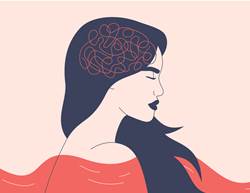When she was 10 years old, Natalie’s* primary school teacher told her mother: “Natalie could be anything she wants to be if only she had someone to organise her.” “I’ve thought about that comment quite a lot since I was diagnosed in 2021 with attention-deficit hyperactivity disorder [ADHD],” says Natalie, 36, who works in the travel industry. “I’ve done fine in my job, but, with the right support and treatment back then, maybe I would’ve finished both the fine arts course and design course that I started but dropped out of in my 20s,” she says.
“I had a dream of becoming an illustrator, but the study felt exhausting and frustrating. I’d read over and over the information, but couldn’t take it in because my thoughts kept racing off and distracting me.” Getting her diagnosis sooner would also have prevented years of self-criticism, over her lack of time management skills and constant forgetfulness. “Ten times a day I’d be looking for where I put my swipe card at work,” Natalie explains. “When I made up the baby formula, I’d have to count out loud how many scoops I put in the bottle, otherwise every single time I’d lose track. As I couldn’t remember to take the contraceptive pill every day, I’ve had to opt for a hormone implant. My husband has had to be the one who handles all our bills.”
What does ADHD feel like?
Excessive inattentiveness is a common symptom of ADHD and a red flag that leads women to be screened for the condition in adulthood. By this stage, they may have spent years masking their condition while harbouring huge shame and embarrassment about behaviour blips – like turning up to a doctor’s appointment late or on the wrong day. Again. Or being a ‘no show’ to pick up the kids. Again.
For years, on her popular news and lifestyle website mamamia.com.au, media personality Mia Freedman, 51, fessed up about forgetting to pick her kids up from school or sport or play dates. Though it was a running joke in her family, she admitted these moments gave her bad mother guilt. So, when she was recently diagnosed with ADHD at 49, it proved a major ‘aha’ moment.
“Behavioural quirks that I’d had all my life were growing into obstacles and then liabilities,” wrote Mia as she described escalating symptoms that now included having more minor car accidents (including backing into her son’s car twice in a few months in her driveway). She was also missing more meetings and then struggling to stay on message when she turned up. “It was impossible to concentrate, my thoughts flicking around incessantly, unable to land on any one thread for more than a few seconds,” Mia says.
Only months before, Aussie author, performer and radio personality Em Rusciano had also revealed her 2021 ADHD diagnosis. “I’d always joked that I had ADHD because of my relentless ambition, fast brain, impulsivity, rubbish memory, inability to regulate my emotions, complete lack of organisational skills and inability to speak at a normal pace,” Em, 43, joked when delivering her emotional 2022 National Press Club address in Canberra. Yet, though she remembers feeling inadequate because she couldn’t ace spelling bees or recite her times tables, when it came to art, sport and drama, Em excelled.
It’s a common story mirrored by other celebs with ADHD, such as American Olympic gymnast Simone Biles, actor and comedian Jim Carrey, actress Zooey Deschanel and singer Justin Timberlake. “Many people with ADHD end up doing very well in creative or sporting careers,” says Associate Professor John Kramer, chair of a special interest group for the Royal Australian College of GPs that supports research and education into conditions like ADHD.
“It’s a big myth that if you have ADHD you can’t focus on anything,” says Natalie, who was always very good at printmaking and ceramics. “To manage my symptoms over the years, I’ve had to become very pedantic. So, if a work task requires thorough checking and accuracy, I do it well, but I have to minimise distractions around me. I’ve since learnt that this hyper-focus is common in people with ADHD – so, at home, I can really lose myself in playing classical guitar or doing ink cartoon drawings of very busy, detailed scenes. Yet the phone might ring and, during a conversation with a girlfriend, I might then interrupt constantly and impatiently finish her sentences.”
Why girls and women miss are undiagnosed
Flashback 30 years and ADHD, which was then called attention deficit disorder (ADD), was usually diagnosed in boys who talked fast, acted out and lacked focus. “Meanwhile, girls with the condition who sat looking out the window were often overlooked even though they too weren’t concentrating and their learning was often falling behind,” says Associate Professor Kramer. “So, any current rise in diagnosis of women is a correction, because, for decades, girls
with ADHD have been slipping through the net.”
“About three boys for every girl have ADHD,” agrees Dr Tamara May, a psychologist and research fellow at Monash University in Melbourne, who specialises in ADHD. “But, in adulthood, a similar number of men and women have ADHD. What this likely means is that many girls with ADHD weren’t recognised in childhood.”
The knock-on effects can be major, causing multiple job changes, relationship breakdowns and even self-medication with alcohol or substances like cannabis, often to deal with anxiety, which is a lesser-known symptom of this ‘neurodevelopmental’ condition, which affects brain function, but the ‘how’ of this is not well understood. And half of those affected never grow out of it. For decades, we’ve relied on overseas medical manuals to guide ADHD diagnosis and these only started recognising adult ADHD diagnosis 10 years ago. But, in 2022, after two years of development, new Australian ADHD diagnosis guidelines have been released after approval from our National Health and Medical Research Council. When experts and people with ADHD looked at all the latest evidence for the guidelines, “It was clear that what urgently needs to be addressed are the girls slipping through the net and the women still going undiagnosed,” says Dr May, who worked as project manager on the new guidelines.
Detractors say the spike in adult diagnosis is just a trend and that we’re medicalising totally normal life blips like forgetfulness, brain fog and anxiety, which affect most modern women, because we’re under the pump 24/7. “This misses the reality of the huge impacts of ADHD and the rigour of diagnosis,” says Dr May. “To be diagnosed with adult ADHD, symptoms must be chronic, affect function and quality of life and be evident in two settings, such as work and home.”
Getting a diagnosis
ADHD has three main sub-types. Some people are more hyperactive/impulsive, some mostly inattentive and others, like Em, have a mixture of both. “This means I have a really fast brain and live in a dream world all the time,” she said in her press club delivery. Many undiagnosed women spend years masking their ADHD or avoiding activities that spotlight their symptoms. But, the wheels may start to fall off in their 30s, 40s and 50s when they’re juggling career, kids and, sometimes, ageing parents, too, and may start really struggling to keep all the balls in the air.
Often people with ADHD become less hyperactive with age, but also more inattentive or restless. “At this point, women’s symptoms may mistakenly be put down to postnatal depression or perimenopause or menopause,” says Associate Professor Kramer. “They’re also at higher risk of being misdiagnosed with bipolar disorder, borderline personality disorder and anxiety disorder, which might lead them to be prescribed medications that don’t work because they’re being treated for the wrong condition.”
The turning point often comes when a child is diagnosed with ADHD, which often kicks in around age 12. “When looking back, Mia described her younger self as “impatient, obsessive, anxious, impulsive, restless, fidgety and with a pathological fear of stillness.” These childhood symptoms add an important piece to the puzzle of adult ADHD diagnosis.
Screening involves a big-picture approach that takes in everything from school reports and cognitive assessments to questionnaires. “As there’s a strong genetic tendency, it’s now standard practice after a child is diagnosed to ask if another family member shows signs of the condition,” says Associate Professor Kramer. This was how Vivian Dunstan, 56, who now runs ADHD Support Australia, ended up being screened and diagnosed; her 14-year-old daughter was found to have ADHD first.
“For years I’d wondered if I was on the spectrum, because I felt I could be scatty and, though I often feel I live at warp speed, I’m really terrible with time – repeatedly mixing up the time I have to arrive at an appointment with the time I have to leave,” Vivian says. “Luckily, my partner, who I’ve been with since I was 18, covers for me – he gets me up in the mornings and, if we go on holiday, he makes all the bookings and gets us to the airport on time. Otherwise, I’d most likely miss the flight. It’s like my brain is going at a different speed to other people and I’ve felt like that since I was a kid – which is why I loved gymnastics because I could jump around and burn off energy.”
Treating ADHD
Stimulant medication, such as Ritalin and dexamphetamine, can be a life-changer for adults with significant ADHD symptoms. It impacts dopamine and norepinephrine, brain chemicals linked to attention and focus. “We also recommend support from psychologists and specialised ADHD coaches,” says Associate Professor Kramer. “They can help newly diagnosed women increase their repertoire of coping approaches, which may include lists, regular routines and setting rituals linking two tasks together so they remember to do them.”
“Since taking medication, I’ve felt calmer, less chaotic and less teary and I’m also less distracted, so I find it much easier to focus,” says Natalie. “I can now even fold the washing without going off and leaving it half done – this might sound like no big thing, but it’s a huge deal for me. There’s also less chatter in my head, which no longer feels like it’s spinning all the time. It may have come late, but being diagnosed with ADHD as an adult has been a relief and has improved my self-esteem and quality of life.”
Could you have ADHD?
ADHD involves more than forgetting where you put your glasses or impulsively buying a new Prada bag. According to psychologist and ADHD specialist Dr Tamara May, there are three main sub-types and the symptoms can substantially impact a person’s quality of life:
1. INATTENTIVE: This causes forgetfulness, difficulty organising and planning, seemingly careless mistakes, lack of attention to detail and trouble focusing and sustaining attention.
2. HYPERACTIVE/IMPULSIVE: This can lead to constant restlessness, a busy mind, difficulty sitting still, fidgeting, impatience and being overly talkative and interrupting others.
3. COMBINATION: This means that people have a mix of both inattentive and hyperactive/impulsive symptoms.
If you think you might have undiagnosed ADHD, talk to your GP about being screened, also known as a diagnostic evaluation. For more information on ADHD, visit adhdsupportaustralia.com.au. You can also download the new ADHD diagnosis guidelines from the Australian ADHD Professionals Association at adhdguideline.aadpa.com.au/download.










